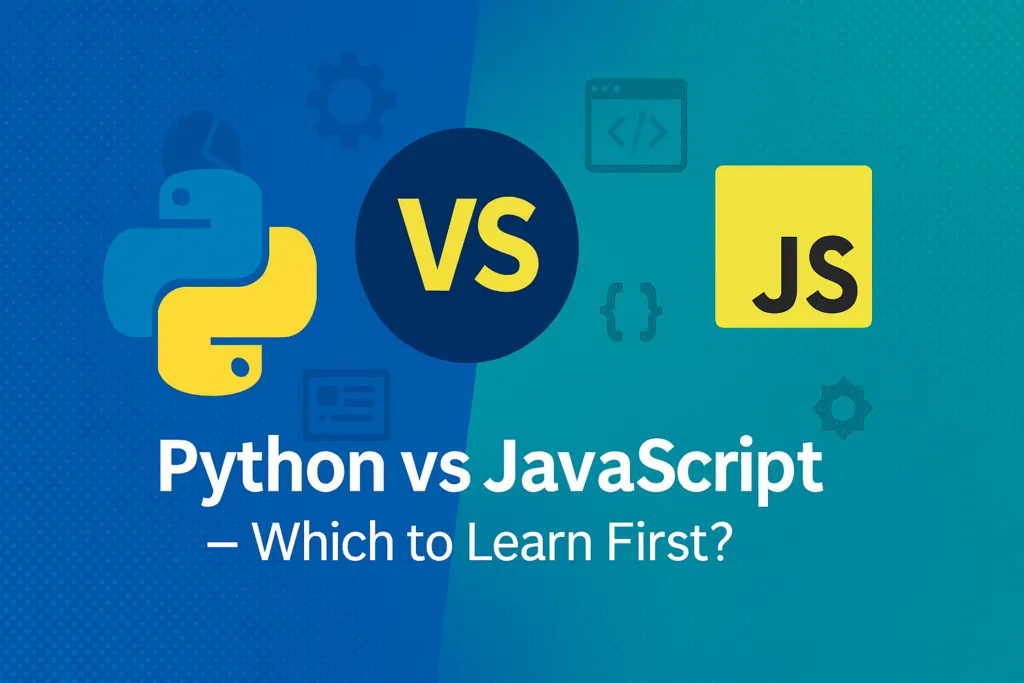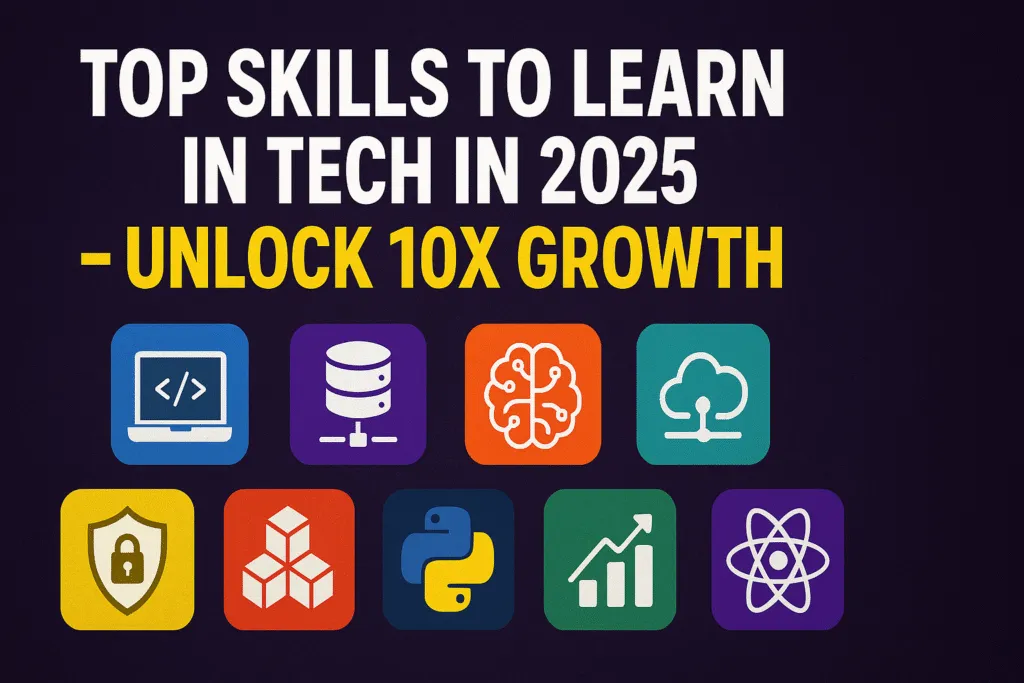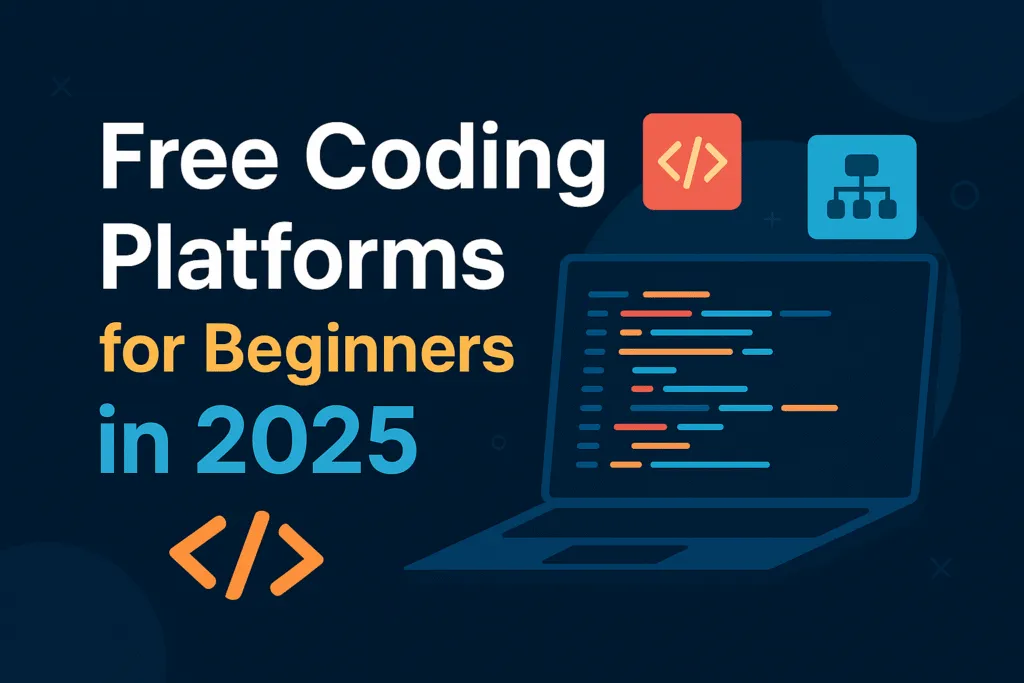Introduction – Why Choosing the Right Language Matters
If you’re just beginning your coding journey, you’ve likely come across the comparison of Python vs JavaScript. Both are popular, powerful, and beginner-friendly languages, but choosing the right one first can shape your learning experience, career path, and confidence as a developer. With countless tutorials and resources available, the decision can feel overwhelming. That’s why it’s important to understand what each language brings to the table before diving in.
Python is known for its clean syntax, making it ideal for beginners who want to focus on logic rather than complicated code structures. It’s widely used in data science, automation, AI, and backend development. JavaScript, on the other hand, is the backbone of modern web development. If your goal is to build interactive websites or work in frontend or full-stack development, JavaScript might be the better starting point.
When comparing Python vs JavaScript, it’s not about which is superior, but rather which aligns best with your goals. Are you more interested in data or design? Do you want to build AI models or dynamic web pages? Your answers will guide your decision. Making the right choice early on saves time, reduces frustration, and helps you build projects that genuinely excite you.
Overview of Python
Python is a high-level, interpreted programming language that has become one of the most popular choices among beginners and professionals alike. It is known for its simple and readable syntax, which closely resembles plain English. This makes Python a go-to language for those just starting their programming journey, as it allows learners to focus more on problem-solving and less on complex syntax rules.
In the python vs javascript debate, Python stands out for its versatility. It’s widely used in data science, artificial intelligence, machine learning, automation, backend web development, and even game development. Major companies like Google, Netflix, and NASA rely on Python for various internal tools and systems, highlighting its scalability and reliability.
Another reason for Python’s popularity is its strong community support. Whether you’re a student or a professional developer, you’ll find countless tutorials, libraries, and frameworks like Django, Flask, Pandas, and TensorFlow that make development faster and more efficient. Python also works across platforms, so your code can run on Windows, macOS, and Linux with little to no modification.
While it may not be the best fit for building interactive front-end applications, Python’s role in automation and data-centric applications makes it a powerful choice. If you’re aiming for careers in data science or AI, Python might be the perfect first language to learn.
Overview of JavaScript
JavaScript is a powerful, high-level programming language that plays a central role in web development. If you’ve ever interacted with a dynamic website—clicked a button, submitted a form, or seen content change without reloading the page—that’s JavaScript at work. In the python vs javascript discussion, JavaScript dominates the frontend space and is essential for creating interactive, user-friendly websites.
Unlike Python, which is often used behind the scenes, JavaScript runs directly in the browser. It works seamlessly with HTML and CSS to build everything users see and interact with on a webpage. With the rise of powerful frameworks like React, Angular, and Vue.js, JavaScript has expanded beyond basic scripts to full-scale web applications.
But JavaScript isn’t limited to the frontend. Thanks to Node.js, it’s now a popular choice for backend development too, enabling full-stack development with a single language. This makes it easier for developers to manage both client and server-side code, reducing the need to learn multiple languages early on.
JavaScript also benefits from a massive global community and an ever-growing ecosystem of tools, libraries, and learning resources. Whether you want to become a web developer or explore full-stack development, JavaScript offers the speed and flexibility needed to build modern applications. It’s an excellent first language for those passionate about web technologies.
Python vs JavaScript: A Side-by-Side Comparison for Beginners
| Feature | Python | JavaScript |
|---|---|---|
| Primary Use | General-purpose programming | Web development (frontend & backend) |
| Ease of Learning | Very beginner-friendly | Slightly more complex for beginners |
| Syntax Style | Clean, simple, and English-like | Uses more curly braces and symbols |
| Frontend Development | Not used | Core language for frontend (web browser) |
| Backend Development | Strong support (Django, Flask) | Strong support (Node.js, Express) |
| Popular Fields | Data Science, AI, Automation | Web Apps, Mobile Apps, UI Interactions |
| Execution Environment | Interpreter (e.g., Python, Anaconda) | Browser & Node.js |
| Job Opportunities | Data Analyst, AI Engineer, Automation | Frontend, Full-Stack, Web App Developer |
| Community Support | Large and helpful community | Massive global developer community |
| Top Frameworks | Django, Flask, TensorFlow, Pandas | React, Angular, Vue, Express |
Learning Curve Comparison
When it comes to choosing between Python vs JavaScript, understanding the learning curve of each language is essential—especially for beginners. Python is often considered one of the easiest programming languages to learn. Its syntax is simple, clean, and very close to plain English. You don’t need to worry about complex rules or unusual symbols, which makes it ideal for those starting with zero coding experience. Most learners can write functional Python code within just a few days of practice.
JavaScript, on the other hand, can feel slightly overwhelming at first. It introduces programming concepts like callbacks, closures, and asynchronous operations early in the learning process. Its syntax includes curly braces, semicolons, and other symbols that may seem intimidating to new coders. That said, JavaScript is not too difficult—it just requires a bit more patience and structured learning.
Another key point in the Python vs JavaScript learning curve comparison is how each language handles errors. Python gives clear and readable error messages that help beginners understand what went wrong. JavaScript’s error handling can be more cryptic at times, especially when dealing with the browser environment or complex asynchronous code.
In short, Python offers a smoother entry point for absolute beginners, while JavaScript requires a slightly steeper climb but pays off well for those interested in web development. Your learning experience will depend on your goals and the type of projects you want to build.
Job Opportunities and Career Scope
When comparing Python vs JavaScript, one of the biggest deciding factors for many learners is career potential. Both languages offer strong job markets, but they lead to different types of roles and industries.
Python is widely used in data science, artificial intelligence, machine learning, automation, and backend development. If you’re aiming for roles like Data Analyst, Machine Learning Engineer, AI Developer, or DevOps Engineer, Python is the clear winner. Companies in finance, healthcare, research, and tech startups all seek Python professionals. The demand for Python developers continues to grow as industries increasingly adopt data-driven strategies.
On the other hand, JavaScript is the foundation of web development. If you’re interested in building websites, mobile apps, or web-based tools, JavaScript opens doors to roles like Frontend Developer, Full-Stack Developer, and JavaScript Engineer. With popular frameworks like React, Angular, and Vue in your toolkit, you can work on fast-paced projects in e-commerce, SaaS, digital marketing, and more.
Another factor in the Python vs JavaScript job comparison is freelancing. Both languages offer great freelance opportunities, but JavaScript dominates the freelance web development scene, while Python freelancing is strong in automation and data-based projects.
In short, Python shines in data and AI-driven roles, while JavaScript rules the web development space. Your career scope depends on the field you’re passionate about and the kind of projects you want to work on.
Web Development: Python vs JavaScript
In the world of web development, the Python vs JavaScript debate takes a more defined shape. Both languages are used to build web applications, but their roles, strengths, and ecosystems are quite different.
JavaScript is the heart of frontend development. It runs directly in the browser and is responsible for making websites interactive. From dropdown menus to real-time updates and dynamic animations, JavaScript powers the user interface. It works closely with HTML and CSS to create responsive and modern web experiences. Frameworks like React, Angular, and Vue have further expanded JavaScript’s power, making it the top choice for client-side development.
Python, however, plays a major role on the backend of web applications. It doesn’t run in browsers but shines when it comes to server-side logic, database handling, and API development. Frameworks like Django and Flask allow developers to build robust, scalable, and secure backend systems quickly. Python’s simplicity also helps teams develop and maintain large web projects more easily.
When comparing Python vs JavaScript in web development, it’s clear that JavaScript is essential for frontend, while Python excels at backend tasks. However, JavaScript with Node.js can also be used for backend development, making it possible to build full-stack applications using just one language.
Ultimately, if you’re aiming to become a full-stack developer or want to focus purely on web technologies, JavaScript is a must. If your interest lies more in handling data, logic, and backend functionality, Python is the better starting point.
Data Science, AI & Automation – Who Wins?
In the Python vs JavaScript debate, when it comes to data science, artificial intelligence, and automation, Python clearly takes the lead. It’s the go-to language for professionals working with data and intelligent systems. Its simple syntax, combined with powerful libraries like NumPy, Pandas, Matplotlib, Scikit-learn, and TensorFlow, makes Python ideal for handling large datasets, training machine learning models, and building AI-powered applications.
Python was designed with readability and productivity in mind, which is crucial when working on complex algorithms or data pipelines. It supports rapid development and has a massive ecosystem of tools specifically built for data processing, predictive analytics, natural language processing, and more. Whether you’re writing a script to automate daily tasks or building a neural network, Python provides all the necessary tools in one place.
JavaScript, on the other hand, is not commonly used for core data science or AI tasks. While there are libraries like TensorFlow.js and Brain.js that bring machine learning to the browser, they’re mostly used for smaller projects or demos. JavaScript’s strength lies in interactive web interfaces—not in data-heavy computing.
In summary, for anyone interested in pursuing a career in data science, AI research, or task automation, Python is the undisputed winner. Its ecosystem, flexibility, and real-world applications make it the first choice for data-driven roles across industries.
Community Support and Resources
One of the most important factors in choosing a programming language is the strength of its community and the availability of learning resources. In the Python vs JavaScript comparison, both languages have massive global communities and offer excellent support for beginners and professionals alike.
Python has been around since the early 1990s and has built a strong, supportive developer base. Whether you’re learning data science, automation, or backend development, you’ll find thousands of tutorials, courses, forums, and open-source projects. Platforms like Stack Overflow, GitHub, and Reddit are filled with Python-related discussions. In addition, documentation for Python and its popular libraries is clean and beginner-friendly, making it easier to find answers when you’re stuck.
JavaScript, being the backbone of the modern web, has an even larger and more active developer community. Because every browser runs JavaScript, it’s often the first language people learn when diving into web development. The JavaScript ecosystem evolves rapidly, with constant updates, new frameworks, and plenty of learning material. From YouTube tutorials and online bootcamps to official docs and GitHub projects, resources for JavaScript are everywhere.
In the end, whether you choose Python or JavaScript, you’ll never be alone. Both languages have vibrant communities that offer support, mentorship, and constant innovation. Your choice depends more on your learning goals than on the availability of help—because in either case, support is just a click away.
Project Examples: What Can You Build with Each?
Understanding what you can build with a language helps you visualize your learning path more clearly. In the Python vs JavaScript debate, both offer exciting project possibilities—but in different domains.
With Python, you can build a wide range of projects, especially if you’re into data and automation. Beginners often start with basic tools like calculators, to-do apps, or automation scripts. As you progress, you can develop more advanced projects like:
- Data analysis dashboards
- Web apps using Django or Flask
- AI-based chatbots
- Machine learning models
- Automation bots (e.g., for web scraping or file handling)
- Recommendation engines
- Backend APIs for mobile or web apps
Python’s ecosystem makes it ideal for building intelligent and scalable solutions in fields like finance, healthcare, education, and logistics.
On the other hand, JavaScript is king when it comes to building interactive and dynamic web interfaces. It runs in the browser, making it perfect for projects like:
- Responsive websites and landing pages
- Single Page Applications (SPAs) using React or Angular
- Real-time chat apps
- Browser-based games
- Progressive Web Apps (PWAs)
- E-commerce frontends
- Full-stack apps (with Node.js for backend)
In short, Python is great for data-heavy, logic-driven projects, while JavaScript is perfect for user-focused, visual, and interactive applications. Depending on what excites you—backend intelligence or frontend creativity—your choice will naturally follow.
Which One Should You Learn First?
Deciding between Python vs JavaScript as your first programming language depends entirely on your goals, interests, and the kind of projects you want to build. Both are beginner-friendly, in-demand, and backed by strong communities, but they lead you down different paths.
If your goal is to enter fields like data science, artificial intelligence, automation, or even cybersecurity, Python is the ideal choice. Its clean syntax and vast ecosystem make it easier for newcomers to understand programming concepts without getting lost in complex code. Python also helps you build practical tools early on—like scripts to automate tasks or analyze data—keeping you motivated as you learn.
On the other hand, if you’re excited about building websites, interactive apps, or working in tech startups as a web developer, JavaScript is the language to start with. It allows you to create real-world, visible projects like websites and user interfaces right from the browser, which is incredibly satisfying for visual learners. Plus, with Node.js, you can later expand into backend development without switching languages.
In the Python vs JavaScript question, there’s no wrong answer. Start with the one that aligns with your passion. The most important step is to begin—because once you master one language, learning the next becomes much easier.
Conclusion – Final Verdict
Choosing between Python vs JavaScript as your first language ultimately comes down to what you want to build and where you see your future in tech. Both are powerful, beginner-friendly, and offer a wealth of opportunities—but they shine in different areas.
If you’re interested in data science, automation, artificial intelligence, or backend systems, Python is the better starting point. Its clean syntax, vast libraries, and supportive community make it perfect for logical, data-driven work. You can quickly start building useful projects and even explore high-paying roles in emerging fields like machine learning and AI.
On the flip side, if your passion lies in building websites, dynamic web apps, or mobile-friendly interfaces, JavaScript is essential. It dominates the frontend world and, with tools like Node.js, allows you to go full-stack using just one language. JavaScript brings your ideas to life on the screen, making it a great choice for creative minds and web enthusiasts.
In the end, whether you choose Python or JavaScript first, you’re making a smart decision. Both languages are future-proof, in high demand, and form the foundation of countless tech careers. Start with what excites you the most—and keep learning. That’s what matters most.
Also Read: Android Smart TVs 2025: Best 4K Display Models Guide
Frequently Asked Questions – Python vs JavaScript
Q1. Which is easier to learn, Python or JavaScript?
Python is generally considered easier to learn due to its simple, readable syntax. It’s great for beginners who want to focus on logic and fundamentals without getting overwhelmed by complex symbols or browser-related issues.
Q2. Can I learn both Python and JavaScript together?
Yes, but it’s better to start with one language, get comfortable, and then move to the other. Learning both at once may cause confusion if you’re a complete beginner.
Q3. Which language has better career opportunities?
Both have great career potential. Python is ideal for data science, AI, and automation roles, while JavaScript is essential for web development and full-stack positions.
Q4. Is Python used in web development?
Yes, Python is widely used for backend development using frameworks like Django and Flask. However, it’s not used for frontend or browser-based tasks.
Q5. Is JavaScript only for web development?
Primarily, yes. But with tools like Node.js, JavaScript can also be used for backend services, APIs, and even desktop or mobile apps.
Q6. Which language should I learn first for freelancing?
JavaScript is often better for freelancing early on, especially in web development. There’s a huge demand for JavaScript-based websites, landing pages, and web apps.


















